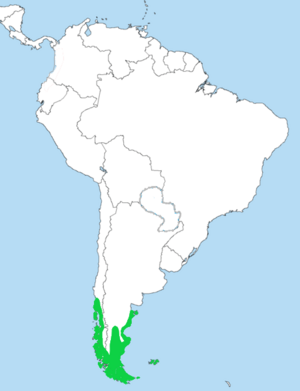Magellanic oystercatcher facts for kids
Quick facts for kids Magellanic oystercatcher |
|
|---|---|
 |
|
| Conservation status | |
| Scientific classification | |
| Genus: |
Haematopus
|
| Species: |
leucopodus
|
 |
|
The Magellanic oystercatcher (Haematopus leucopodus) is a cool bird that loves to hang out near water. It's a type of wader, which means it's a bird that often walks in shallow water. You can find these birds in places like Argentina, Chile, and the Falkland Islands. They live near freshwater lakes and sandy habitats along the coast.
What Does It Look Like?
The Magellanic oystercatcher is about 42 to 46 centimeters (16 to 18 inches) long. That's roughly the length of your forearm! The male birds weigh around 600 grams (about 1.3 pounds). Female birds are usually a little heavier.
This bird has some really striking features:
- It has a long, bright orange beak.
- Its eyes are yellow with a yellow ring around them.
- Its legs are also yellow.
Most of its body, like its head, chest, back, wings, and tail, is black. But its belly and the feathers under its wings are white. When it flies, you can see these white feathers clearly.
It looks a lot like the American oystercatcher. But you can tell the Magellanic oystercatcher apart by the yellow ring around its eye. Also, it's the only oystercatcher in the New World (North and South America) that has a black back instead of a brown one. When it calls, it makes a high-pitched "pee-pee" sound, just like other oystercatchers.
Where Does It Live?
This special bird lives in the southern part of South America. Its home includes southern Argentina, a region called Tierra del Fuego, and other islands nearby. It also lives on the Falkland Islands. Sometimes, you might even spot it on South Georgia and the South Sandwich Islands.
During the time of year when they have their babies, these birds live inland. They prefer upland grasslands. But when it's not breeding season, they move to the coast.
How Does It Live?
The Magellanic oystercatcher is a clever hunter. When it's inland during breeding season, it mostly eats earthworms and insect larvae. It uses its sharp beak to poke around in soft ground and mud to find its food.
When it's at the coast during other times of the year, its diet changes. It looks for mussels and limpets, which are types of shellfish. It also enjoys eating crabs and different kinds of worms that live in the ocean.
If something gets too close to its nest, the Magellanic oystercatcher has some cool tricks to protect its eggs and chicks.
- It might pretend to sit on an empty spot, acting like there's a nest there. This is called "false-brooding."
- It might also do a "tail-flagging" display. This is a special move where it raises its tail and wings to look bigger and scare off intruders.
- It also uses a unique peeping call to warn others to stay away from its home.


